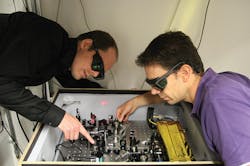Using the Onefive (Zurich, Switzerland) femtosecond laser Origami - 10, Steve Lecomte and his team at the Swiss Center for Electronics and Microtechnique (CSEM; Neuchátel, Switzerland) achieved a record-low relative intensity noise frequency comb and carrier-envelope offset frequency stabilization. The ultrastable performance of the free-running Origami femtosecond oscillator was one of the key factors for the stabilization of the carrier-envelope-offset frequency to a record value of 60 dB signal-to-noise Ratio (SNR); details are published in Electronics Letters.
RELATED ARTICLE: Frequency comb interferometer measures absolute distance
As reported in the featured article, the femtosecond laser is the heart of the frequency comb technology, and its choice is crucial for the performance and reliability of the whole system. Lecomte, head of the Time and Frequency Section at CSEM, chose the Origami laser because of its industrial grade reliability, its high stability, and its very low noise level. The laser does not require any adjustment or maintenance, is very compact, and is the base for the development of an industrial-grade frequency comb targeted for real-world use.
The Origami-based frequency comb performs 2-3 orders of magnitude better than commercial laser systems with similar pulse duration and repetition rate with performance an order of magnitude better than typical systems based on Ti:Sapphire lasers. Origami has a very compact oscillator and a cost-effective design and its ultrastable free-running performance significantly reduces the complexity of the phase-locked loop stabilization electronics. The Origami femtosecond laser can be also used as a stand-alone ultrastable source for all applications where medium-term stability is required. The Origami laser is also an ideal source for coherent supercontinuum generation.
SOURCE: Onefive; http://www.onefive.com/pdf/Onefive_PressRelease_25March2015.pdf

